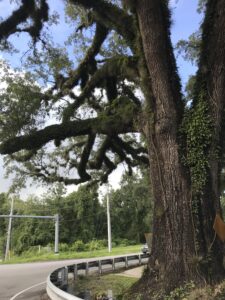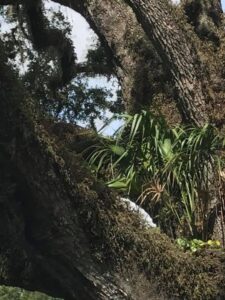S & J Nursery’s Guide to Growing a
Live Oak Tree
for the Northeast Florida Landscape
( Quercus virginiana )
Live Oak Origins:
– Native Florida tree
Live Oak Preferred Exposure:
– Full sun
Live Oak Foliage | Bark:
– Foliage of the Live Oak tree remains evergreen through the winter season
and does not drop leaves until new growth emerges in the springtime.
– Foliage of the Live Oak tree can range from 1 1/2 to 5 inches in
length and is a dark shiny green on the top of the leaf with a whitish green underside.
– Large established trees often draped with Spanish moss (
Tillandsia usneoides )
– With age Live Oak’s bark becomes heavily textured and dark in color.
Live Oak Soil Preference / Salt tolerance:
– Live Oak trees in the North Florida | Jacksonville | St. Augustine landscape will tolerate virtually any soil condition. They are said to thrive on moisture in deep rich soils.
– Salt tolerant
 Live Oak Size Variance:
Live Oak Size Variance:
– Can reach sizes of 40-80 feet H | ad spreading up to twice as wide.
Live Oak Growth Habit:
– Large spreading crown canopy shade tree.
Live Oak Growth Rate:
– Live Oak trees are slow to moderate growers with an extremely long life span.
Live Oak Bloom:
– Inconspicuous flowers followed by acorns
Live Oak Water Requirements:
– regular water
Butterfly or Bird Attracting:
– Live Oaks make a cherished home for birds and are loved by other wildlife, particularly squirrels as well.
Best Uses For Live Oaks in the North Florida | Jacksonville | St. Augustine landscape:
Jacksonville | St. Augustine landscape:
– Live Oak is an excellent choice for an evergreen shade tree in larger
landscapes that allow plenty of room for the trees eventual wide sprawling branches to develop.
– Take care when planting to keep a fair distance from sidewalks, driveways, or other hardscapes so that mature tree roots do not damage them.
Care of Live Oaks:
– Water every day during the establishment period. See watering your newly planted trees for more information.
-They will need good water during the establishment period and supplemental irrigation during dry spells or particularly hot dry summers.
– Prune limbs up and away from structural impediments such as sheds, fences or neighboring trees as they grow.
– Provide a 1 ft diameter circle of mulched area where grass is kept from growing for each inch of caliper (or diameter) of trunk measured 4 inches from the ground level.
– Fertilize each spring with a mixture of Milorganite and a slow release poly coated plant food such as Osmocote or Stay Green general purpose plant food, sprinkling the fertilizer around the mulch circle underneath the foliage of the tree

